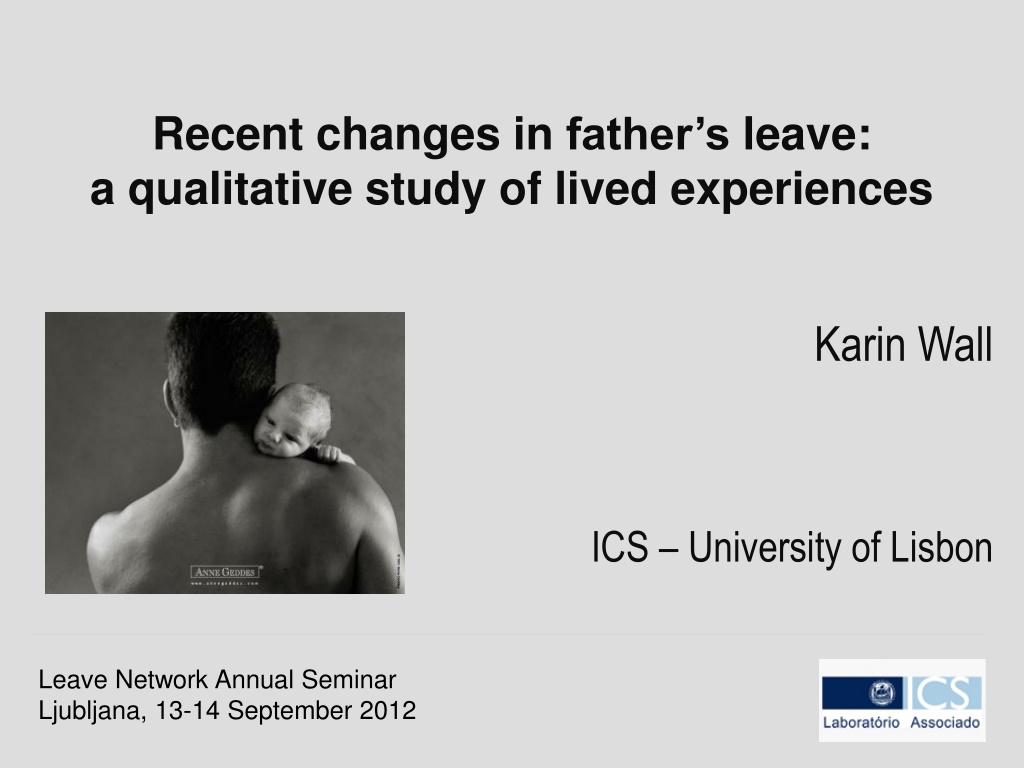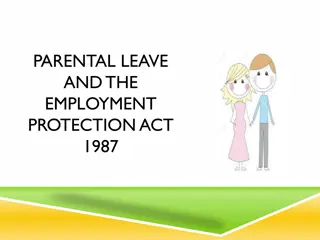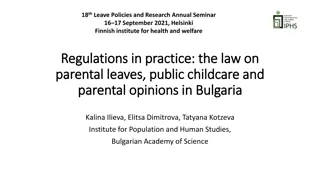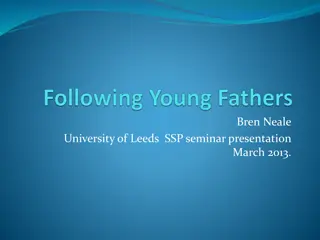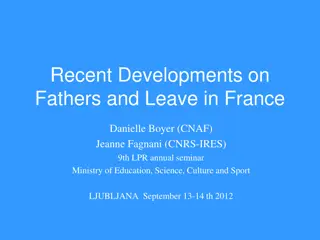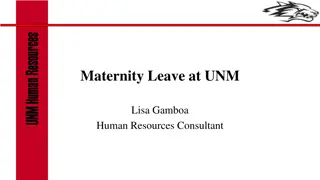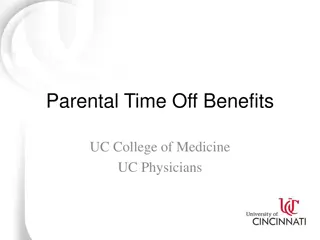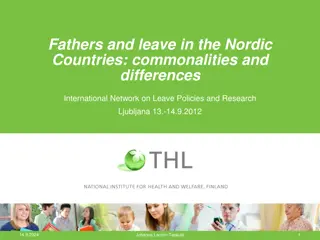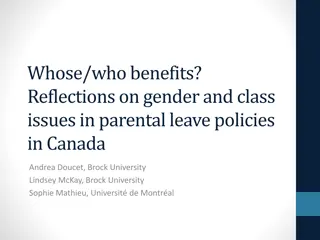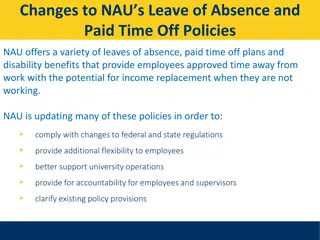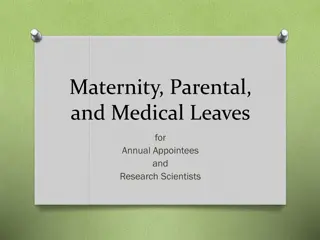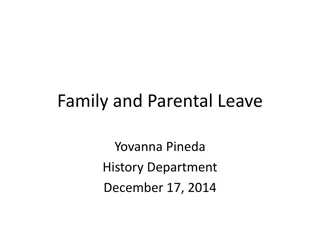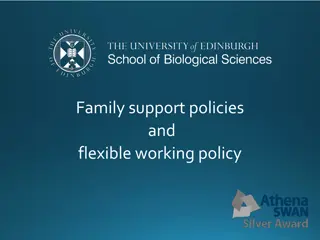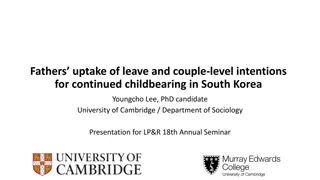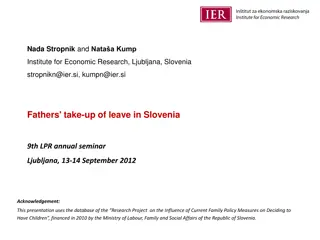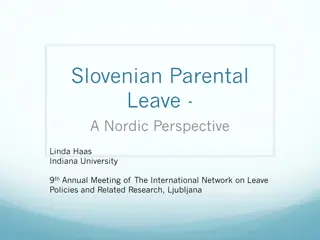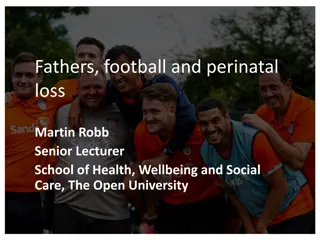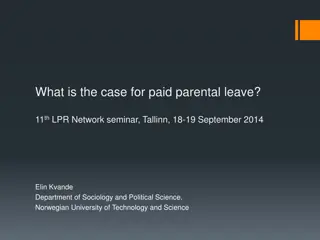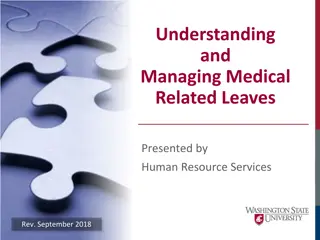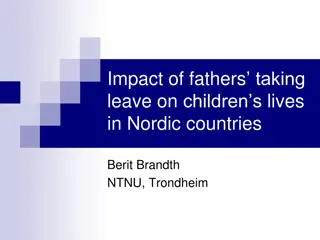Understanding Fathers' Lived Experiences with Recent Changes in Parental Leave Policies
This qualitative study explores the impact of recent legislation changes on fathers' parental leave rights, focusing on fathers who took at least one month of initial parental leave alone. The study examines how these experiences influence traditional gender roles and caregiving dynamics within families.
Download Presentation

Please find below an Image/Link to download the presentation.
The content on the website is provided AS IS for your information and personal use only. It may not be sold, licensed, or shared on other websites without obtaining consent from the author. Download presentation by click this link. If you encounter any issues during the download, it is possible that the publisher has removed the file from their server.
E N D
Presentation Transcript
Recent changes in fathers leave: a qualitative study of lived experiences Karin Wall ICS University of Lisbon Leave Network Annual Seminar Ljubljana, 13-14 September 2012
Introduction: what triggered the study? Most recent change in legislation on maternity/paternity benefits which strengthens father s leave rights (Labour Code, February 2009). Paternity leave (during first mth after birth): from 1 wk to 4 wks (2 compulsory) at 100% New initial parental leave replaces maternity leave. Made up of two elements: it may be shared + incentives to sharing. If the father takes at least 30 consecutive days on his own after the mother has gone back to work the time allowed for well paid initial parental leave increases by one month 2 options: 4 months + 1 paid at 100%; 5 months + 1 paid at 83%. Impact of the change : an increase in the number of couples sharing leave up to 2009 0.6% of couples shared leave in 2011 - 21% of couples (16,719 men ALONE on leave for at least one month) 2
Initial parental leave subsidies granted, with and without sharing of leave (2009-2011) 2009 % 2010 % 2011 % (May-Dec) 12,506 23 16,361 20 16,719 21 Shared* Not shared 41,325 77 64,133 80 64,581 79 53,831 100 80,494 100 81,300 100 Total * Shared leave cases in which each of the partners took initial parental leave on their own for at least 30 days or for two periods of 15 consecutive days while the other partner went back to work. Source: Data supplied by the Instituto de Inform tica e Estat stica da Seguran a social, March 2011 3
The two options (5 months or 6 months) (2009 -2011) 2009 % 2010 % 2011 % 5 months 4,960 44 6,949 42 6,800 41 6 months 6,969 56 9,412 58 9,919 59 Total 12,506 100 16,361 100 16,719 100 Source: Data supplied by the Instituto de Inform tica e Estat stica da Seguran a social, March 2011 4
Main Objective and Research Questions Understanding the lived experiences of fathers who took at least one month alone of initial parental leave. Main focus of existing research: father s use of leave (assessing decisions and determinants of use) + impact on conjugal division of work Haas, Brandth and Kvande, Lammi-Taskula, Rostgaard, Salmi, Chronholm, Anderson, Moss, Deven, Duvander, Karu and Kasearu, Eydal and Gislason, Huttunen, Almqvist, O Brien, Pajumets, Takala, Nyman and Peterson, Olson, Meil, Holter 2 Questions: From the men s point of view, how did they perceive leave and what did they do and experience during that period of leave? (what social processes and what effects are associated with this period of time when the father is on leave on his own) To what extent do these lived experiences affect the more conventional models of masculinity and femininity (nurturing mother main carer/ providing father supportive carer) ? 5
Approach Dual theoretical approach : - The interactionist perspective : emphasizes the autonomous nature of the actor, who constructs and negotiates his or her practices - The structural perspective : emphasizes the influence of normative and institutional contexts (constraints) 6
Normative and Institutional Contexts GOVERNMENT/LEGISLATION: new leave scheme which prioritizes the incentive to child- bearing, gender equality through the strengthening of fathers rights and the incentive to share parental leave, and better reconciliation of work, family life and early infant care (Decree-Law 91/2009). PROFISSIONAL GROUPS(pediatricians): discourse on the health and well-being of the child (preferable to remain in a family environment up to 3 years of age) his pediatrician says that the children who are in the cr che need emergency consultations while the children who stay at home only need routine consultations. And with him it s always been like that, the doctors always say that as far as illness and all that is concerned, it s better not to put children into cr ches too early . (David) EMPLOYERS: defending women s rights; expectations long hours, the father does not take leave of absence to care for children; differences between public and private sectors, size and type of organization. GENDER NORMS AND PRACTICES WITHIN THE FAMILY: both partners in full-time work, inequalities in unpaid work, changing norms (hegemonic masculinity the father as provider and educator / hegemonic femininity the mother as main and natural carer). 7
Interview Sample 11 IN-DEPTH INTERVIEWS, MEN living in city of Lisbon AGES: between 28 and 40, 1 aged 54 EDUCATIONAL ATTAINMENT LEVELS:1 with 10 years schooling and a professional qualification, 3 with 12 years of schooling and a professional qualification or attendance at university, 7 with a completed university education SECTORS (SERVICES): 5 private sector, 4 public sector, 2 state corporate sector PROFESSIONS : policeman, accountant, hairdresser, television journalist, aircraft maintenance engineer, sports manager, internet maintenance manager (telecommunications operator), architect, designer, management consultant, computer engineer. COUPLES WITH BOTH PARTNERS IN FULL-TIME WORK : WOMEN S PROFESSIONS: lawyer, judge, radio and television journalists, senior civil servants, civil engineer, secretary, hairdresser, biologist. COUPLES INCOMES: 6 with similar income levels, 2 in which the man earns more, 3 in which the woman earns more; NUMBER OF CHILDREN : 6 with 1 child, 5 with 2 or 3 children. LEAVE TAKEN: paternal and 5th month (3), paternal and 6th month (6), paternal and more than 1 month (2) CARE ARRANGEMENTS OF YOUNGEST CHILD (8 months-2 years of age): 6 in a cr che, 2 with nanny, 1 shared parental leave, 2 grandparents (some with mixed forms of caring until the child is put in a cr che at the age of 7 months to 1 year)8
Results 1: Fathers experiences of parental leave - 6 key processes 1- NEGOTIATION 6- EMOTIONS 2- ACTIVITIES 5- EMANCIPATION 3- LEARNING 4- BONDING 9
6 key processes 1 - NEGOTIATION: with employers, partners, the state; T. and I still thought about whether she would take five and I one, or she would take four and I two, but I couldn t take two months with my job. Even one was bad enough well, it wasn t bad, I can t really say it was bad, I can t compare the work I do with working in a factory, where punishment and reprisals are much more noticeable. But I think there are ways of doing these things. There s no longer any physical whipping, but there are still the psychological blows. That s more like what I went through, that psychological game. At the time, as soon as I knew, I told them because you have to give as much notice as possible with these things that I intended to take a month s leave and that it would be in July of that year. The first question they asked me was why I wanted to take a whole month, wasn t it enough to take just a few days or a couple of weeks (Manuel, aged 34, internet maintenance manager, private company, 1 child) 10
We were updated on the changes in legislation, so we discussed what to do. We preferred that she, my wife, took the maximum she could take and then only after that... I came on the scene. Well, because she was breastfeeding and so this was an advantage. I think we sort of assumed it would be so, our approach was quite traditional from that point of view. And then, of course, we thought it was important to do what we could to put off the moment when the baby went to the cr che.... Her sisters at four months were so small on the first day at the cr che. And then there was another aspect to the decision: my wife s job. It was always very difficult for my wife to stay away from the courts for long, the work piles up and you can t lose track... So we didn t want her to.... We had to find a point of balance between trying to care for the baby at home for a bit longer without penalizing our working lives too much . R., computer engineer, wife judge, 3 children, option 4 plus one month 11
6 key processes 2 - ACTIVITIES: caring, housework, leisure it was a very demanding month I was with him. He d wake up, I d give him his bottle, then he would go back to sleep a bit more during the morning, then I would play with him, I was here with him. Then I d make lunch, tidy up, spend part of the afternoon with him, interacting with him, playing. Then, well, he would sleep a bit more, but almost every time I thought I d take a bit of a rest after tidying up and having done all that stuff, he would wake up. It was an almost never-ending cycle, with no rest in between, it s really very tiring looking after a kid all day (Rafael, 28 years of age, management consultant, private company, 1 child) 12
6 key processes 3 - LEARNING: becoming an INDEPENDENT CARER, taking on RESPONSIBILITY, learning EMOTIONAL CARE and testing oneself I have a clear idea that I reminded myself to say right,it s time to feed, or give him the bottle, it s time to go to sleep ( ) I may even have done the same things before - [with his other children] - , in fact I m sure I did, but it was always with my wife to guide me. This last time I was home alone, so I acted more responsibly ( ) but I also managed to get over that initial panic, of saying whenever he cried he s crying, what shappening? and I said to myself, right, this must be the nappy or it must be time to give him the bottle , so there was a bit less panic, my reactions were a bit better organized and rational, let s say, and practical maybe, yes, more practical (Roberto, 54 years of age, computer engineer, state corporate sector,3 children) That s when we truly become parents, isn t it? When we have such a close tie to them that we know just by the kind of crying, or by his manner, what he wants it s that kind of awareness which I think is very important, I think it shows how close you are, and that is what it really means to BE A FATHER . (Rafael, 28 years of age, management consultant, private company, 1 child) 13
6 key processes 4 - BONDING: stronger ties between FATHER and SON, HUSBAND AND WIFE, family members, and between generations (proximity, connection, affection, consolidation, mutual understanding, sharing, involvement ) During that time I spent alone with my daughter, she developed a very strong bond with me, got very close to me. Actually she got so close to me that when she woke up at night she only wanted me, she only quietened down with me. We are very good friends, we two (Leonardo, 32 years of age, hairdresser, 2 children) There s no-one else there, and that creates a stronger bond I don t know, when people say there s a stronger tie between mother and baby, I think that tie between mother and baby is transferred to the father, in this way at least that s what I felt . (Joaquim, 39 years of age, accountant in the civil service, 3 children) I always used to do a lot, but when I stayed at home by myself, that s when I understood the important little things that happen in day-to-day life, and I think that helps me to appreciate the other side as well ( ) because I had to do those things I think we got to know each other better, and I think it actually helped our relationship quite a bit (Manuel, 34, internet manager in a private company, 1 child) 14
6 key processes 5 EMANCIPATION: subverting gender relations, moving away from pre-conceived male and female roles I think equality ( ) is not just household chores, it s not just your worries, not just the shared leave With all due respect, and I think it s very important I think it s the other side, really understanding the man, ( ) That other side is more of an effort, isn t it? It s more of an effort. Making meals, being at home all day, that s an effort, so it s good to share that aspect, let s share that side. The other thing is I can even sleep with him here close beside me, feel his warmth, even though I (the man) have to wake up and go and fetch him, then it s look, go and fetch him , right,I ll stick with the worst part which is going to get him, and you get the best part, which is staying with him. Why don t we share it the other way round? You go there, make up the bottle, you go and fetch him and I ll give it to him in bed . That doesn t happen, but I think that s the next step, that may be the next step (Manuel, 34, internet manager in a private company, 1 child) 15
6 key processes 6 - EMOTIONS: pleasure, liking, happiness, satisfaction, willingness, ability, responsibility, confidence (in oneself/the future of the child), connection, proximity, affection, friendship, challenges, testing oneself, pride, calm, empathy, mutual understanding, tiredness 16
Results 2: Diversity of experiences 4 PROFILES CONSTRAINED FUNDAMENTAL BREAK INNOVATION and INDEPENDENCE INNOVATION - SUBVERSION 17
Profile CONSTRAINED A third party is present and helps with the caring ( the interviewee s mother who helps out, a domestic employee ). The father has a greater sense of responsibility, learns a little, but sees himself as a supportive father (in contrast to the mother as the main and natural carer). The period of leave is appreciated mainly from the child s point of view and for strengthening family ties. The fact that the father is left alone is less important. 18
Profile FUNDAMENTAL BREAK The period of leave is experienced as a key moment, a fundamental break with highly differentiated gender roles. The period of leave offers a time of unexpected freedom and independence, in a dual earner/female carer context. Interviewees continue to see themselves as supportivefathers , but are more confident, having discovered a domain which is not mediated by the mother 19
Profile INNOVATION and INDEPENDENCE In this profile the involved father on leave becomes an independentcarer to whom all tasks can be delegated. The period of leave brings little in the way of new learning ( I already knew how to do that , Ididn t need a parachute ), but it is the final step towards full autonomy. The men in this profile see it as a period of intense acitvity (with varied tasks) and increased responsibility (seeing themselves as independentfathers ). In addition to strengthening bonds between father and child, this profile highlights the importance of creating empathy with the mother s feelings of tiredness when she is the sole carer. Leave sharing is seen as a positive thing for the family as a whole (strengthening bonds between father and child, partners, and triangular bonds); the time the father spends alone (1 or 2 months) is seen as being of special importance. 20
Profile INNOVATION-SUBVERSION In this profile the father becomes an independentcarer, but he also regards the period of leave on his own as a fertile ground for building gender equality (he sees himself as an egalitarian father and partner who is at the heart of the family, as his wife is). The man tests himself out , embarking on tasks which he regards as difficult (going out, planning, having people in), and becomes more reflexive with regard to gender relations, questioning those differences between men and women which are conventionally held to be natural. This profiile not only strengthens bonds, but also enables the period of leave to be viewed as a time when parents are able to question and deal with in-built cultural norms relating to gender roles. 21
Conclusions 1. Diversity of lived experiences of solo father-caring 2. What factors encourage the innovation-subversion of gender roles profile? A project and desire for individualized parenthood, i.e. taking everything on, on one s own, and doing it in one s own way (tied in with the perception of the man as an independent and equal actor in the home, one who may adopt the role of the mother) Pro-active behaviour (agency) on the part of the father: an extra effort, in other words testing himself out (being sure that he knows how to do everything and more) Egalitarian (dual earner/dual carer) couples, in norms and practices, who deconstruct and neutralize gender in family roles and places (all things may be done by him or her) Family-work reconciliation values focused on the importance of the family and not just work (Men with similiar or lower professional status and income levels as partner + medium to high educational and occupational attainment levels) (Work contexts may be more or less favourable. When they are less so, the man fights for his rights) 22
Conclusions 3. Most valued characteristics of the new leave scheme for work-family balance An extra month of well-paid leave for parents (fathers do not lose income) Being able to care for a child at home for longer, between 6 and 12 months (6 months well-paid, 6 months at 25% previous earnings) Couples share the professional costs of absence from work. Costs for employers are also distributed. Bolsters father s skills and confidence in unpaid work, also enhancing understanding of work-family stress 23
Study Fathers on parental leave Contacts: karin.wall@ics.ul.pt ; scmarinho@ics.ul.pt; OFAP- Observat rio das Fam lias e das Pol ticas de Fam lia http://www.observatoriofamilias.ics. ul.pt/index.php 24
